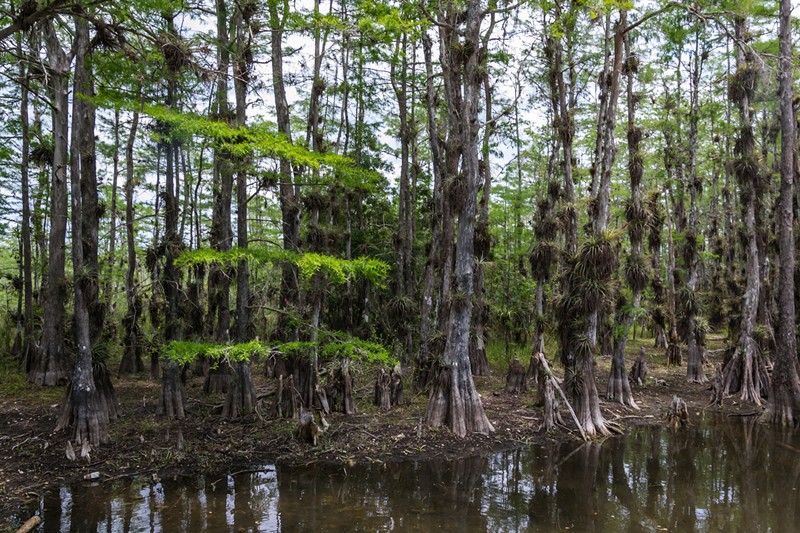South Florida's Big Cypress National Preserve is aptly named for its abundance of large cypress trees. The 720,000-acre stretch of land is one of the last few large chunks of protected Everglades wetland in South Florida — but thanks to a web of nefarious, manmade problems, the site will likely look very different within the next 50 years.
For one, oil company trucks are driving through the area in a search for possible stores of black gold buried underground, which does not bode well for a federally protected preserve.
And now Florida International University researchers warn that, thanks to sea-level rise, the bald cypress trees on the preserve might not survive much longer. According to an FIU study published in the peer-reviewed journal Environmental and Experimental Botany, rising oceans mean an infusion of more saltwater into the wetland ecosystem — and some of the preserve's cypress trees aren't equipped to handle that much salt. FIU's ecologists warn that humans might need to add chemicals to water in areas such as Big Cypress to prevent all of the trees from dying.
“Different species can be killed by salinity in different ways,” FIU ecologist Lu Zhai says in a statement about the study. “Adding nutrients to areas where bald cypress trees are dying can help mitigate the impacts of salinity.”
According to the study, bald cypress trees submerged in salt water can't get the right mix of nutrients. As more salt water pours in, the trees find it increasingly difficult to grow healthy leaves.
This is far from the first study warning that saltwater intrusion is bad for the Everglades. For thousands of years, the River of Grass remained a remarkably pristine ecosystem. The water was extremely clear and largely uncontaminated, even as various Native American groups lived amid the foliage. Then Northern settlers arrived, plowed a railroad through the Everglades, drained huge portions of the swamp, diverted south-flowing water sideways, and crammed huge cities, highways, and farms on top of one of the world's unique ecosystems. Now the Glades' water is polluted by a host of contaminants, including phosphorous from agricultural runoff.
On top of that, salt water is creeping closer into the heart of the swamp as the oceans rise. Previous studies have noted that rising seas will likely kill all sorts of unique Everglades flora: Coastal mangroves, for example, are engaged in a "death march" toward land. The mangroves have historically blocked portions of South Florida from tidal flooding and storm surges, but rising oceans continue to push the plants closer to paved, urban areas. Eventually, the trees will have nowhere to go and will likely vanish, leaving the previously protected areas of the coast bald and exposed to encroaching waves.
Last year, the International Union for Conservation of Nature (IUCN) named the Glades the most "critically endangered" site in America thanks to pollution, human tampering, and climate change. That report noted that saltwater intrusion and sea-level rise are already affecting the natural habitats of wading birds.
"Some of these losses cannot be restored, as habitat features have taken decades to centuries to develop," the IUCN warned last November. "Potential threats, including hurricanes, climate change, and ocean acidification, to the site are a high threat overall and are potentially being realized already."
Worse yet, plant death in the Glades might make climate change even worse: A 2016 study noted that mangroves naturally absorb billions of dollars' worth of human-made carbon emissions.
In compiling the latest study, FIU ecologists studied bald cypress trees in North and South Carolina, which are similar to those that inhabit Big Cypress and other parts of South Florida.
"Bald cypress, a seasonally deciduous species, is affected more by nutrient stress compared to water stress because leaf emergence occurs during periods of low salinity," the researchers warn.
Of course, the preserve faces an even more pressing issue right now: Massive trucks from the Texas-based energy firm Burnett Oil are hunting for alleged oil or natural gas. Those trucks have been filmed plowing giant tracks through protected, natural areas — and if those trucks strike oil, the end may be near for Big Cypress.

Audio By Carbonatix
[
{
"name": "Air - MediumRectangle - Inline Content - Mobile Display Size",
"component": "19274298",
"insertPoint": "2",
"requiredCountToDisplay": "2",
"watchElement": ".fdn-content-body",
"astAdList": [
{
"adType": "rectangle",
"displayTargets": "mobile"
}
]
},{
"name": "Editor Picks",
"component": "17482312",
"insertPoint": "4",
"requiredCountToDisplay": "1",
"watchElement": ".fdn-content-body",
"astAdList": [
{
"adType": "rectangle",
"displayTargets": "desktop|tablet"
},{
"adType": "rectangle",
"displayTargets": "desktop|tablet|mobile"
}
]
},{
"name": "Inline Links",
"component": "18711090",
"insertPoint": "8th",
"startingPoint": 8,
"requiredCountToDisplay": "7",
"maxInsertions": 25
},{
"name": "Air - MediumRectangle - Combo - Inline Content",
"component": "17482310",
"insertPoint": "8th",
"startingPoint": 8,
"requiredCountToDisplay": "7",
"maxInsertions": 25,
"watchElement": ".fdn-content-body",
"astAdList": [
{
"adType": "rectangle",
"displayTargets": "desktop|tablet"
},{
"adType": "rectangle",
"displayTargets": "desktop|tablet|mobile"
}
]
},{
"name": "Inline Links",
"component": "18711090",
"insertPoint": "8th",
"startingPoint": 12,
"requiredCountToDisplay": "11",
"maxInsertions": 25
},{
"name": "Air - Leaderboard Tower - Combo - Inline Content",
"component": "17482313",
"insertPoint": "8th",
"startingPoint": 12,
"requiredCountToDisplay": "12",
"maxInsertions": 25,
"watchElement": ".fdn-content-body",
"astAdList": [
{
"adType": "leaderboardInlineContent",
"displayTargets": "desktop|tablet"
},{
"adType": "tower",
"displayTargets": "mobile"
}
]
}
]












